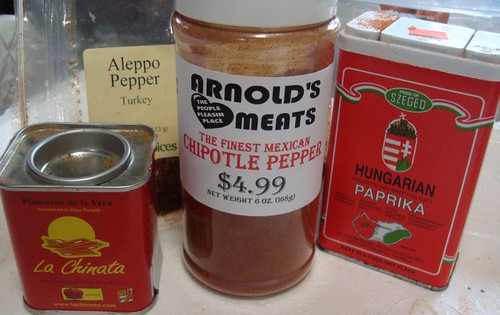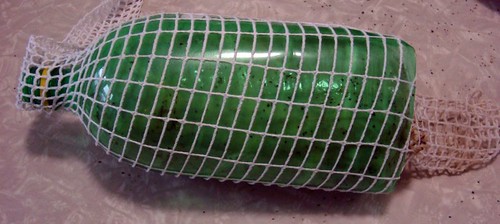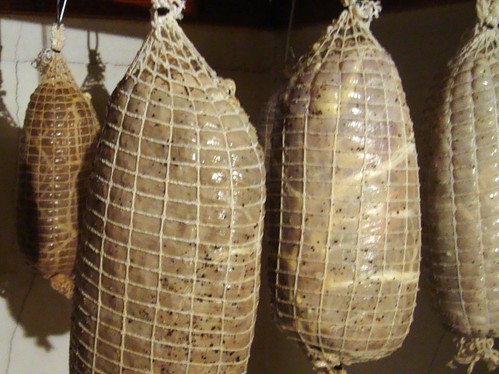It's that time of year again - even though I'm about a week or so later than last year - and the pork loins are hanging in my attic curing room, slowly and magically turning into capicola. You can refer back to this post from last year as a starting point if you'd like to see how to make your own, step by step. This time around, I'm only going to go over some changes we made in the process.
Also, I'd like to thank the many people I've corresponded with via email, and who've shared their own methods and memories about curing capicola.
One of the changes we made this year was in the way we season our hot capicola. Traditionally, sweet capicola is made by coating the loin with coarsely ground black pepper before casing them and hot capicola is made by coating the pork with powdered cayenne or other hot red pepper. But cayenne pepper is not a big favorite of mine; in my opinion, it gives heat without lending flavor and I've never been a fan of heat for heat's sake. So my friend Roger and I developed a hot seasoning that would give a pleasant burn and also allow the flavor of the peppers to enhance the concentrated porkiness of the cured capicola.
 We started with about a quarter cup of coarsely ground black pepper, which was left over from coating the sweet cappies. That will give a fruity base to seasoning and means we won't be wasting any leftovers (which I don't keep after having raw pork rolled around in it.) Then we added about 3 ounces of chipotle pepper powder, 1/4 cup of imported Hungarian paprika (we used sweet for flavor, but you could use hot for an extra kick,) a little over an ounce of smoked imported Spanish paprika, and a handful of coarsely ground Turkish Aleppo pepper (a lit like crushed Italian red peppers, but a bit moister and with a much richer red-pepper flavor.) Measurements are approximate because I cook as much "by eye" as I do "by spoon." As with any other ingredients, quality is key. Buy the best spices you can afford. My favorite sources are Penzey's (where I got the Aleppo) and Nutmeg Spice Company (which puts up big canisters of spices for many different markets such as Arnold's Meats, where I bought the one shown above.)
We started with about a quarter cup of coarsely ground black pepper, which was left over from coating the sweet cappies. That will give a fruity base to seasoning and means we won't be wasting any leftovers (which I don't keep after having raw pork rolled around in it.) Then we added about 3 ounces of chipotle pepper powder, 1/4 cup of imported Hungarian paprika (we used sweet for flavor, but you could use hot for an extra kick,) a little over an ounce of smoked imported Spanish paprika, and a handful of coarsely ground Turkish Aleppo pepper (a lit like crushed Italian red peppers, but a bit moister and with a much richer red-pepper flavor.) Measurements are approximate because I cook as much "by eye" as I do "by spoon." As with any other ingredients, quality is key. Buy the best spices you can afford. My favorite sources are Penzey's (where I got the Aleppo) and Nutmeg Spice Company (which puts up big canisters of spices for many different markets such as Arnold's Meats, where I bought the one shown above.)
Also, I'd like to thank the many people I've corresponded with via email, and who've shared their own methods and memories about curing capicola.
One of the changes we made this year was in the way we season our hot capicola. Traditionally, sweet capicola is made by coating the loin with coarsely ground black pepper before casing them and hot capicola is made by coating the pork with powdered cayenne or other hot red pepper. But cayenne pepper is not a big favorite of mine; in my opinion, it gives heat without lending flavor and I've never been a fan of heat for heat's sake. So my friend Roger and I developed a hot seasoning that would give a pleasant burn and also allow the flavor of the peppers to enhance the concentrated porkiness of the cured capicola.
 We started with about a quarter cup of coarsely ground black pepper, which was left over from coating the sweet cappies. That will give a fruity base to seasoning and means we won't be wasting any leftovers (which I don't keep after having raw pork rolled around in it.) Then we added about 3 ounces of chipotle pepper powder, 1/4 cup of imported Hungarian paprika (we used sweet for flavor, but you could use hot for an extra kick,) a little over an ounce of smoked imported Spanish paprika, and a handful of coarsely ground Turkish Aleppo pepper (a lit like crushed Italian red peppers, but a bit moister and with a much richer red-pepper flavor.) Measurements are approximate because I cook as much "by eye" as I do "by spoon." As with any other ingredients, quality is key. Buy the best spices you can afford. My favorite sources are Penzey's (where I got the Aleppo) and Nutmeg Spice Company (which puts up big canisters of spices for many different markets such as Arnold's Meats, where I bought the one shown above.)
We started with about a quarter cup of coarsely ground black pepper, which was left over from coating the sweet cappies. That will give a fruity base to seasoning and means we won't be wasting any leftovers (which I don't keep after having raw pork rolled around in it.) Then we added about 3 ounces of chipotle pepper powder, 1/4 cup of imported Hungarian paprika (we used sweet for flavor, but you could use hot for an extra kick,) a little over an ounce of smoked imported Spanish paprika, and a handful of coarsely ground Turkish Aleppo pepper (a lit like crushed Italian red peppers, but a bit moister and with a much richer red-pepper flavor.) Measurements are approximate because I cook as much "by eye" as I do "by spoon." As with any other ingredients, quality is key. Buy the best spices you can afford. My favorite sources are Penzey's (where I got the Aleppo) and Nutmeg Spice Company (which puts up big canisters of spices for many different markets such as Arnold's Meats, where I bought the one shown above.)The other change we made this year was in the actual process of putting up the capicola itself. First off, we didn't use butcher's string to tie off the casings at the ends. We used small plastic wire-ties. They gripped the casings quite effectively and were much easier and tighter than string.
We also used elastic netting over the casings, rather than wooden slats, to provide compression as the capicola cures. Several readers wrote in and told me they get great results with the netting, so I ordered a roll of it and we're trying it out. There's a trick to getting it over the capicola, though - you need some sort of tool to do it, because it's nearly impossible to just pull it over the cased meat like a sock.
 I cut the bottom end off of a 2-litre plastic soda bottle. To wrap the capicola, we put each capicola into the bottom of the bottle and pulled the elastic over the tapered end. Then we tied off the bottom end of the netting and pulled the bottle out the other side, leaving the capicola perfectly encased in the elastic web. This took about half the time that it would have taken us to strap them. We left extra at the top end to curl around to accomodate a hanging hook.
I cut the bottom end off of a 2-litre plastic soda bottle. To wrap the capicola, we put each capicola into the bottom of the bottle and pulled the elastic over the tapered end. Then we tied off the bottom end of the netting and pulled the bottle out the other side, leaving the capicola perfectly encased in the elastic web. This took about half the time that it would have taken us to strap them. We left extra at the top end to curl around to accomodate a hanging hook.
I hope the texture comes out as well as it does with the straps. It should - the netting provides compression evenly over the entire ham, while the slats concentrate the pressure at four points.
 At right you can see the capicola, hanging deliciously in the curing room. We'll visit them periodically to see how they're doing, just like we did last year.
At right you can see the capicola, hanging deliciously in the curing room. We'll visit them periodically to see how they're doing, just like we did last year.Links:
Penzey's Spices - You owe it to yourself to pay them a visit; one of the best selection of high-quality herbs and spices anywhere. I've been buying stuff from them since before the internet!!
Nutmeg Spice Company - A local Connecticut company that provides exceptionally hig-quality merchandise under both their own label and custom grocery-store and other private labels in New England. I've never had a bad experience with them.

18 comments:
You lucky man, you have an attic. I am an envious apartment dweller without a place to hang meat. If my wife came home to some lovely pork loins swaying in the breeze in my kitchen, I would be residing in my truck. I am however, exploring the idea of getting a small wine fridge to perform some hacks on. I have heard for small scale sausage ageing they work very well.
I would like to say thank you for taking the time to post this. I started to cure Capicola for the first time and looking forward to it. I would like to ask for aging the Capicola is ok if its aged in a room where I store my demi-johns of wine? Is there a chance the wine or the meat wont age well or spoil?? I have heard this from some Italians.
First off thanks for the step by step posts last year, I just stumbled on them recently and have some pork curing right now, just about ready to be rinsed and put in casings.
I have a few questions though. Is it reasonable to add herbs like oregano to the spices before aging? If it starts to get too warm can I put the meat in the fridge during the hottest hours of the day, and rehang it when it cools down? Also what happens if you take the meat down early and cook it rather than leaving it up the whole 3 months?
Robert: As long as the temperature is cool enough to keep the pork cool while it's aging, there shouldn't be any reason for either the wine or the meat to spoil. My own curing room is a closet in my attic; I've never done anything special to it other than add rods to hang the meat and line the floor with newspaper to catch drips during the first couple weeks of curing. The capicolas are not very fussy about where they hang and seem to be a lot more resistant to spoilage than we give them credit for.
Michael:You should feel free to experiment with herbs and spices as you wish. My own desire to fiddle around with the traditional recipe led me to try the very non-traditional hot cure we used this year. I think I would use dried herbs rather than fresh, though, because it's easier to control the flavor level from batch to batch. And yes, you can move the capicola to the fridge if you're worried about the temperature getting too warm in your curing area. Last year, one of my capicola was nowhere near done by the time the attic started warming up for the year. So I just took it down and put it on one of the shelves in the fridge, all the way in back, for another month. It came out great. I'm less sure about cooking it. By the middle of the curing time it's already lost a lot of moisture, but will still be soft and very moist toward the center. I suppose you could cook it like a country ham, but I have no experience with it and I really can't give you any reliable guidance for that.
Thanks so much you are awesome. Unfortunately now I've hit a pretty big roadblock, my beef middles are closer to an inch and a half wide than 3 1/2 inches, and the only place in the Portland OR area that appears to sell them tells me that's as big as they come. Any suggestions?
Michael: Ask for beef bung cap. They're closed on one end and about eighteen inches long or so. If you can't find them locally, you can order them from sausagemaker.com but be warned that they're going to cost you about five dollars each (each one will hold two half-loins.)
Thanks man, I'll have try that next time I guess, the guys here mentioned that, but don't have them. For now I guess I'm gonna cut the pork in half and make some skinnier capicola. Should be a stronger flavor I'm guessing, which will be nice. Thanks again for the help and quick responses.
Michael: Cutting the loins down to fit in the middles that you have will work, and the capicola will come out just fine. The only thing that you'll need to do is be extra vigilant checking on them. They will take less time to cure and dry than a full-sized loin - start checking them for doneness after about a month. You'll know when they're done because they will be firm and barely yield to the pressure of a gently squeeze. I'm guessing they'll be ready after a little over 8 weeks, but be patient because of your curing conditions and the size of the loins.
Good luck!
Thanks Dave. Hey just yesterday I someone told me he puts his Capicoli in a nylon stocking rather then regular castings for aging. He then puts them in the elastic netting and ages. Hes been doing it for 20 years and says they come out fantastic. He apperently had a bad expierience with castings that rotted and now does this. Have you ever heard of this??
Robert: that's the first time I've ever heard of that, but I can't think of any reason why it wouldn't work.
I've never had a casing rot, but I have had some interesting-looking molds develop on them. For the most part, the molds never penetrate through the casings, and they've never been harmful varieties, only the beneficial kinds.
Well I decided to do my 6 Capicolas with nylon casings today and was lucky to find some netting from Italy that fit way more snug then then netting i found in Montreal Canada. I followed you Dave step by step execpt for the casing i used nylon. I'll wait the 12 weeks and let you know what gives. Again, I wanna TY for everything.
PS Dave if ever you are in Montreal let me know, so i can offer you my wine and hospitality!
Robert: Good luck, and I hope your capicolas turn out well. Let me know.
And if you ever make it down to the Hartford CT area, send me an email. It's be great to meet you.
Just want to know where to buy the elastic netting and what size?
Thanks
Karen
Karen - I get the #16 size casing from www.sausagemaker.com. It seems to be the perfect size for capicola.
how long can you keep cured store bought cappicola? one year, two? Sometimes I see really good sales ($3.50 lb) for 2-4 lb size cappicola... How long will they store?
Dave,
I have been reading your blog for the past year and are ready to start my own batch in the coming weeks. I saw early you live near Hartford, CT. I am from New Britain, CT. I plan on curing in my attic so i hope to have the same results as you. Thanks for all the info.
Dean
Dave
Can you freeze capicola after you slice it, I do this with lonza .
Thanks
John
I think you can freeze it.
Post a Comment